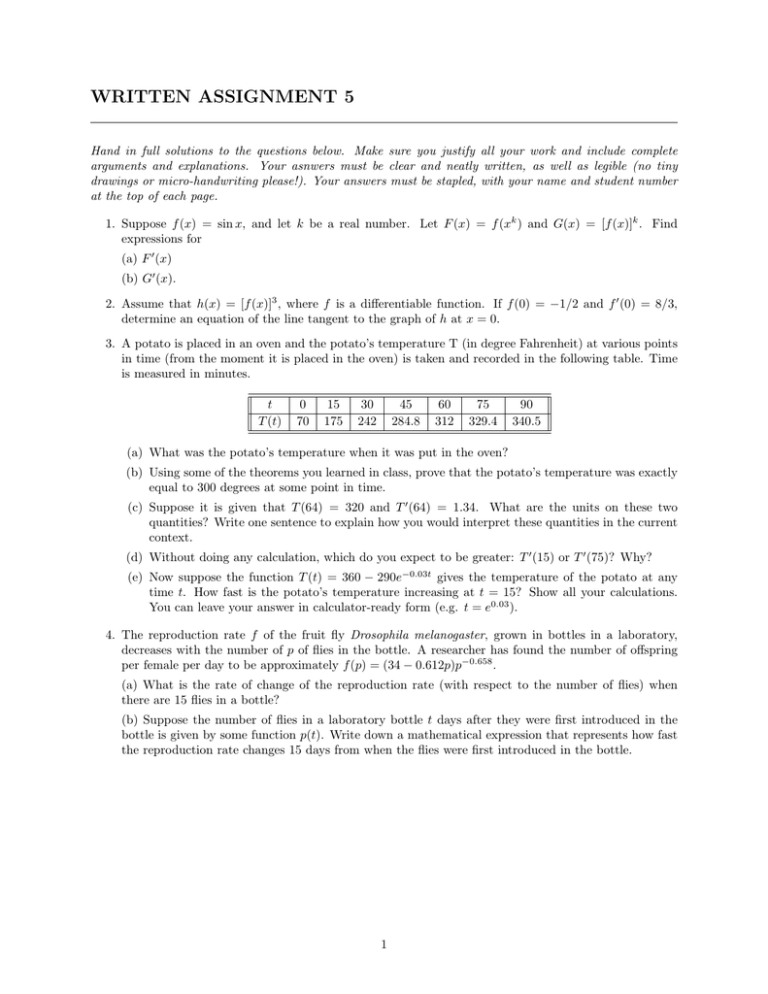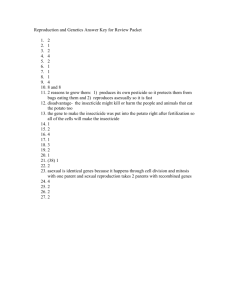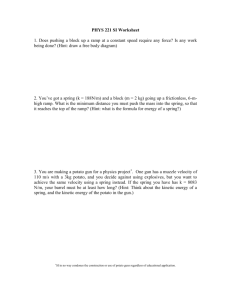WRITTEN ASSIGNMENT 5
advertisement

WRITTEN ASSIGNMENT 5 Hand in full solutions to the questions below. Make sure you justify all your work and include complete arguments and explanations. Your asnwers must be clear and neatly written, as well as legible (no tiny drawings or micro-handwriting please!). Your answers must be stapled, with your name and student number at the top of each page. 1. Suppose f (x) = sin x, and let k be a real number. Let F (x) = f (xk ) and G(x) = [f (x)]k . Find expressions for (a) F 0 (x) (b) G0 (x). 2. Assume that h(x) = [f (x)]3 , where f is a differentiable function. If f (0) = −1/2 and f 0 (0) = 8/3, determine an equation of the line tangent to the graph of h at x = 0. 3. A potato is placed in an oven and the potato’s temperature T (in degree Fahrenheit) at various points in time (from the moment it is placed in the oven) is taken and recorded in the following table. Time is measured in minutes. t T (t) 0 70 15 175 30 242 45 284.8 60 312 75 329.4 90 340.5 (a) What was the potato’s temperature when it was put in the oven? (b) Using some of the theorems you learned in class, prove that the potato’s temperature was exactly equal to 300 degrees at some point in time. (c) Suppose it is given that T (64) = 320 and T 0 (64) = 1.34. What are the units on these two quantities? Write one sentence to explain how you would interpret these quantities in the current context. (d) Without doing any calculation, which do you expect to be greater: T 0 (15) or T 0 (75)? Why? (e) Now suppose the function T (t) = 360 − 290e−0.03t gives the temperature of the potato at any time t. How fast is the potato’s temperature increasing at t = 15? Show all your calculations. You can leave your answer in calculator-ready form (e.g. t = e0.03 ). 4. The reproduction rate f of the fruit fly Drosophila melanogaster, grown in bottles in a laboratory, decreases with the number of p of flies in the bottle. A researcher has found the number of offspring per female per day to be approximately f (p) = (34 − 0.612p)p−0.658 . (a) What is the rate of change of the reproduction rate (with respect to the number of flies) when there are 15 flies in a bottle? (b) Suppose the number of flies in a laboratory bottle t days after they were first introduced in the bottle is given by some function p(t). Write down a mathematical expression that represents how fast the reproduction rate changes 15 days from when the flies were first introduced in the bottle. 1






